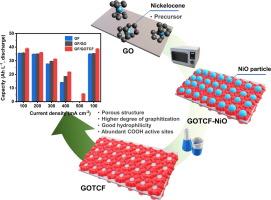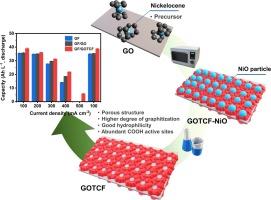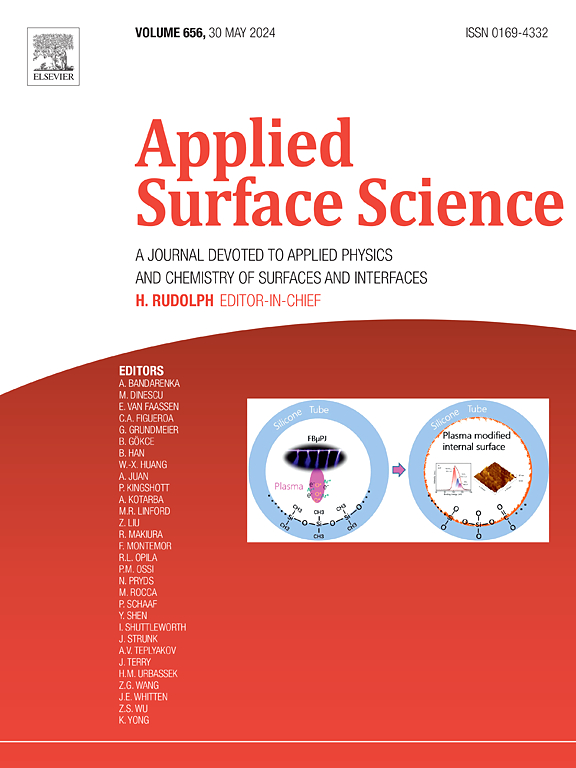氧化石墨烯上的介孔石墨碳:钒氧化还原液流电池的高性能催化剂
IF 6.3
2区 材料科学
Q2 CHEMISTRY, PHYSICAL
引用次数: 0
摘要
在氧化石墨烯(GO)表面合成了氧化石墨烯模板碳框架(GOTCF),作为钒氧化还原液流电池(VRFB)的高效催化剂。通过微波辐照和后处理两步合成,形成了具有多孔结构和高含氧官能团含量的石墨碳,从而提高了钒离子氧化还原反应(VIRR)的催化性能。经过后处理后,与原始石墨烯相比,其表面积增加了 15 倍,主要呈现介孔特征,而氧含量却没有显著降低,从而优化了电子和离子传输,提高了对 VIRR 的催化活性。与使用原始 GO 的电极相比,GOTCF 电极的电荷转移电阻降低了 50% 以上,峰值电流密度提高了约 30%,这些都证明了 GOTCF 电极在 VIRR 方面的卓越性能。单电池 VRFB 测试表明,即使在高电流密度条件下(400 mA cm-2),基于 GOTCF 的电极也能实现明显更高的能量效率和稳定的容量性能。此外,经过 500 次循环后,GOTCF 电极的初始容量保持率超过 89.3%,超过了 GF 和 GF/GO 电极的耐久性,从而证实了它们在 VRFB 应用中作为稳定催化剂的潜力。本文章由计算机程序翻译,如有差异,请以英文原文为准。


Mesoporous graphitic carbon on graphene oxide: A high-performance catalyst for vanadium redox flow batteries
Graphene oxide templated carbon framework (GOTCF) was synthesized on the surface of graphene oxide (GO) as a highly efficient catalyst for vanadium redox flow batteries (VRFBs). A two-step synthesis involving microwave irradiation and post-treatment resulted in enhanced catalytic performance towards vanadium ion redox reactions (VIRR) through the formation of graphitic carbon with porous structure and high oxygen-containing functional group content. Subsequent to post-treatment, a 15-fold increase in surface area with a predominantly mesoporous feature compared to pristine GO was observed without a significant decrease in oxygen content, optimizing electron and ion transport, thereby enhancing catalytic activity towards VIRR. Electrochemical evaluations demonstrated the superior performance of the GOTCF electrodes for VIRR, as evidenced by the greater than 50 % reduction in charge transfer resistance and approximately 30 % higher peak current densities compared to those of the electrode utilizing pristine GO. Single-cell VRFB tests revealed that the GOTCF-based electrodes achieved significantly higher energy efficiencies and stable capacity performance, even under high current density conditions (400 mA cm−2). Moreover, after 500 cycles, the GOTCF electrodes retained over 89.3 % of their initial capacity, surpassing the durability of GF and GF/GO electrodes, thus confirming their potential as robust catalysts for VRFB applications.
求助全文
通过发布文献求助,成功后即可免费获取论文全文。
去求助
来源期刊

Applied Surface Science
工程技术-材料科学:膜
CiteScore
12.50
自引率
7.50%
发文量
3393
审稿时长
67 days
期刊介绍:
Applied Surface Science covers topics contributing to a better understanding of surfaces, interfaces, nanostructures and their applications. The journal is concerned with scientific research on the atomic and molecular level of material properties determined with specific surface analytical techniques and/or computational methods, as well as the processing of such structures.
 求助内容:
求助内容: 应助结果提醒方式:
应助结果提醒方式:


